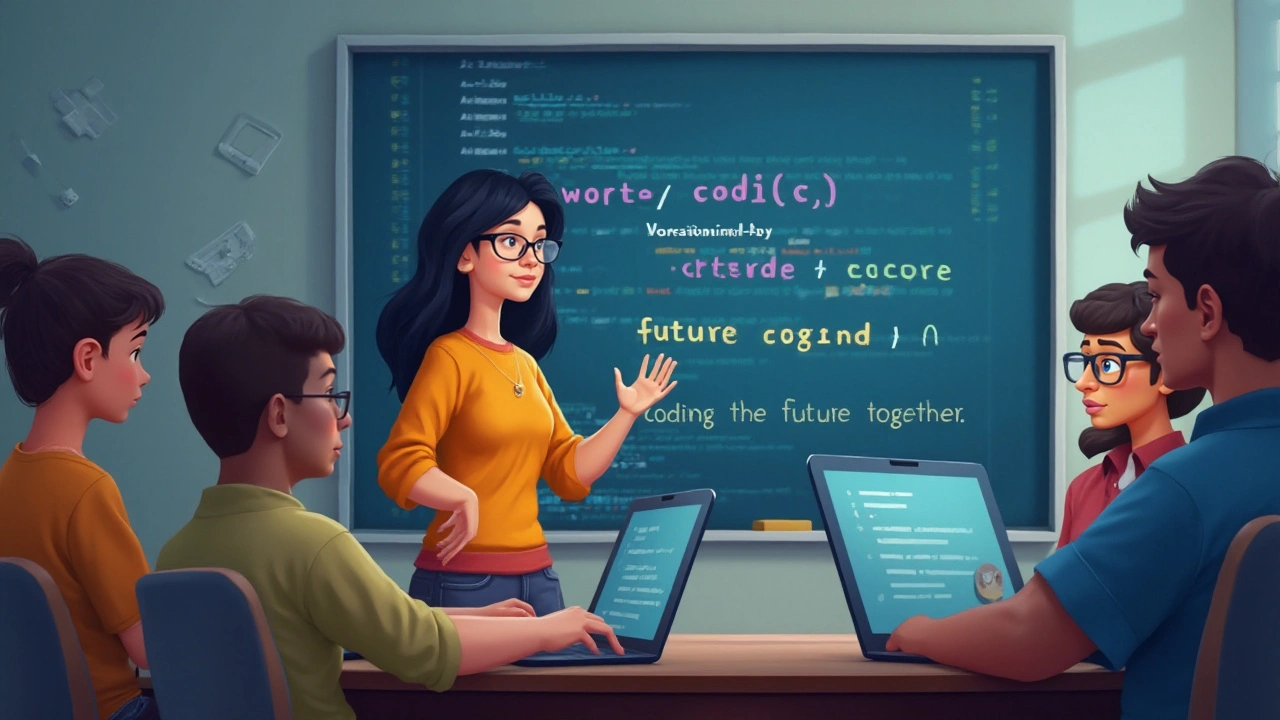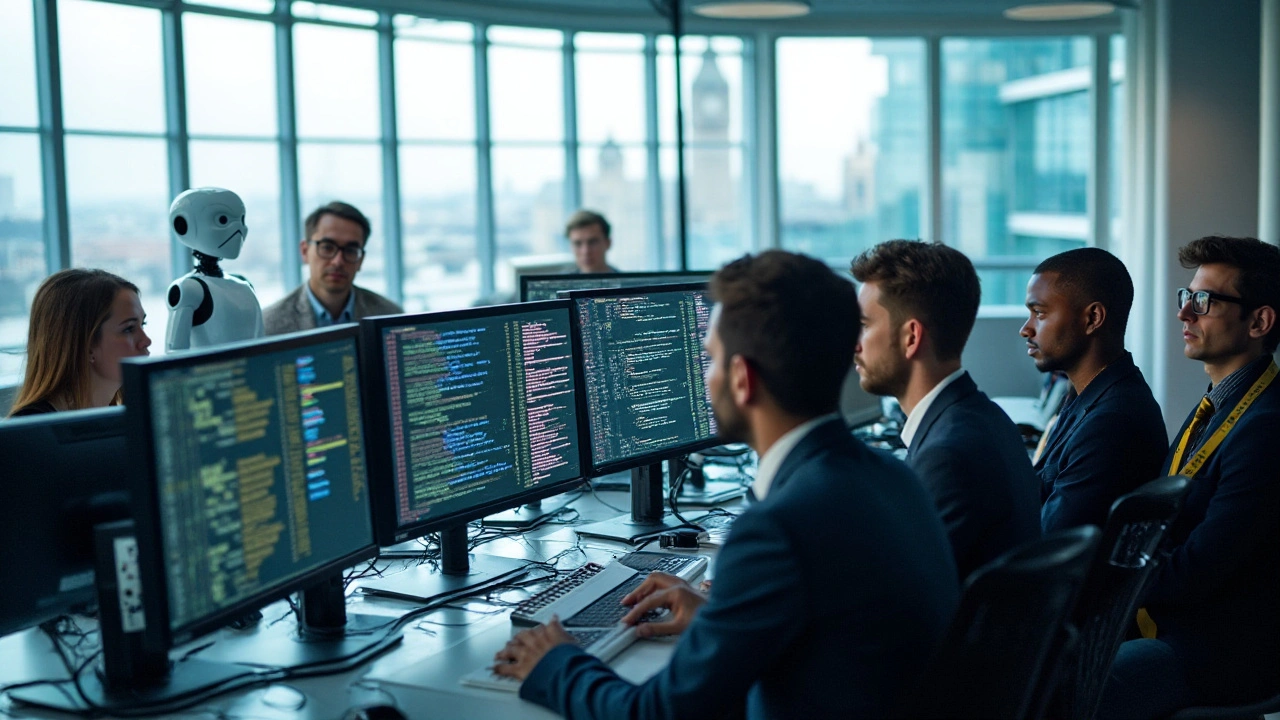As the digital world evolves, artificial intelligence continues to have a huge impact on the way we code and create software. Right now, AI isn't just a buzzword; it's a driving force behind technological progression, shaping how problems are solved and applications developed. Developers and tech enthusiasts need to get a good grasp of this transformation to keep up with the ever-changing landscape.
Machine learning, a subset of AI, stands at the forefront of this revolution. It refers to the process by which a computer can learn and improve from experience without explicit programming. This incredible capability is unlocking new potential in how we approach software creation. Not only does it offer enhanced efficiency, but it makes software smarter—maybe even more creative, in its own way.
The world of AI is teeming with new tools and techniques, each more groundbreaking than the last. Whether it’s sophisticated algorithms or intuitive frameworks, these innovations are revolutionizing coding as we know it. By diving into these areas, developers can significantly enhance the functionality and user experience of their creations.
- Introduction to AI in Coding
- The Role of Machine Learning
- Innovative Tools and Techniques
- Future Trends in AI Coding
- Practical Tips for Developers
Introduction to AI in Coding
Over the past decade, the fast-paced world of technology has seen Artificial Intelligence (AI) make significant strides in reshaping the coding landscape. Not merely a theoretical concept, AI is now a practical tool leveraged across industries to accelerate development, optimize efficiency, and drive innovation. At its core, AI involves creating systems capable of performing tasks that require human intelligence, such as recognition, decision-making, and language understanding, among others. The coding community, ever adaptable, has embraced these AI capabilities, recognizing them as allies in a complex digital environment rather than as potential threats.
Machine learning, a vital branch of AI, plays a pivotal role in how coding is approached today. It gives programs the ability to learn from past experiences and adapt without direct intervention. This acquired self-sufficiency is enabling more intelligent code configuration, where AI can suggest improvements, detect anomalies, and even predict the outcome of specific operations. For instance, modern Integrated Development Environments (IDEs) are already equipped with AI features that lend smart code suggestions, reducing bugs and improving software performance with precision. One can hardly overlook the integration of neural networks—algorithms inspired by the human brain framework—into coders' toolkits, enhancing the capacity of applications to process massive data sets efficiently.
The profound impact of AI on coding is marked by the presence of sophisticated tools designed to automate mundane tasks. Say goodbye to repetitive manual testing and welcome AI-driven automation. Chatbots, for example, rely on AI algorithms and have become common in consumer interactions, showcasing the versatility and efficiency that AI delivers. Companies like Netflix and Amazon embrace AI for personalized recommendations, a testament to how AI is becoming embedded in software systems for tailored user experiences. A survey by Deloitte revealed that 73% of IT professionals view artificial intelligence and machine learning as game-changing technologies, particularly in their capacity to address scalability challenges.
When discussing AI in coding, it's essential to mention the role of AI-powered code generators and their growing popularity. Tools like OpenAI's Codex and GitHub Copilot have garnered attention for their ability to turn natural language prompts into functional code. These innovative solutions highlight AI's potential to act as a companion to programmers, enhancing productivity by handling repetitive coding tasks or generating boilerplate code. AI is thus reshaping what it means to be a developer, not by replacing the human element but by complementing and extending it. As Kevin Kelly aptly mentioned, “AI will transform coders into experts capable of concentrating on core ideas and logic instead of getting tangled in syntax and conventions.”
Amid all these advancements, one cannot ignore the ethical considerations and challenges that AI brings to the coding domain. Critics raise valid concerns about AI decision-making processes, privacy, and the potential for biased outputs. It is crucial for developers to proceed with a blend of enthusiasm and caution, ensuring that AI's implementation upholds ethical standards and mitigates risks. These discussions will undoubtedly shape the roadmap for AI integration in coding, emphasizing the need for transparency and accountability within AI systems. As the conversation on AI ethics continues to evolve, coders remain at the center, driving change and advocating for responsible AI deployment.
The Role of Machine Learning
Machine learning isn't just a tech buzzword anymore; it's at the heart of every modern AI application and has been pivotal in transforming how we approach programming challenges today. Over the last decade, machine learning has rapidly matured from a theoretical concept into practical solutions that power industries. Its role in AI coding is tantamount to an artist finding the right canvas and paints to bring imagination to life, offering ways to explore datasets and derive insights that humans might overlook.
The algorithms developed through machine learning allow systems to identify patterns, predict outcomes, and improve autonomously without needing explicit instructions at every step. This adaptability is what thrusts machine learning to the forefront of tech innovation. In healthcare, for example, machine-learning models are being used to predict patient diagnoses with accuracy rates that sometimes surpass seasoned medical professionals. Similarly, financial sectors exploit its capabilities to improve fraud detection and optimize investments.
One of the most potent aspects of machine learning in coding is the development of neural networks, which are designed to mimic the operations of the human brain. These networks consist of layers of interconnected nodes that process data iteratively, making them capable of learning complex relationships between variables. The rise of neural networks has been likened to the invention of electricity in the scope of their potential impact. As Andrew Ng, a co-founder of Google Brain, stated, "AI is the new electricity. Just as electricity transformed numerous industries in the past century, AI will likely do the same now."
"Machine learning is a core, transformative way by which we're rethinking everything we're doing. We're thoughtfully applying it across all our products, whether it's search, ads, or YouTube," commented Sundar Pichai, CEO of Alphabet.
Tools and frameworks like TensorFlow and PyTorch have democratized machine learning, making it accessible not just to tech giants but to solo developers and startups. These platforms provide the infrastructure for developers to build, train, and deploy machine learning models efficiently. A fascinating aspect of these tools is their open-source nature, which means they continually evolve with contributions from an active global community. This open collaboration ensures that the toolsets stay cutting-edge, allowing developers to create smarter, faster applications.
The opportunities in machine learning are vast, yet the field is constantly evolving. As new data is generated every second around the globe, the need for machine learning coders who can harness this information to derive actionable insights becomes more crucial. For developers, understanding and integrating machine learning principles into their workflow not only opens doors to new realms of possibilities but also ensures that they remain competitive in an era where AI is quickly becoming ubiquitous. The balanced fusion of human intuition with machine intelligence marks this unique juncture in the tech world—a juncture that promises to redefine the future boundaries of human capability.

Innovative Tools and Techniques
In the ever-evolving domain of AI coding, cutting-edge tools and techniques are surfacing, shaping how developers approach software creation. These innovations not only enhance the efficiency of coding practices but also push the boundaries of what is technologically feasible. Many developers today rely on tools like TensorFlow and PyTorch, which are popular for their comprehensive libraries aiding machine learning development. These frameworks facilitate building deep-learning models, which are pivotal in automating complex tasks and analyzing vast datasets. The significance of these tools lies in their ability to democratize AI, enabling developers across skill levels to access sophisticated technologies.
AI coding is also being revolutionized by advancements in automated machine learning (AutoML). AutoML solutions like Google's Cloud AutoML and H2O.ai's Driverless AI simplify the model selection and hyperparameter optimization process. This automation drastically reduces the time developers spend on iterative testing, allowing them to focus more on innovation and creative problem-solving. These platforms use intuitive interfaces to guide developers through building tailored ML models, ensuring that even those with minimal ML experience can excel in creating effective solutions.
As Fei-Fei Li, a leading AI scientist, once said, "AI is everywhere, and its impact is only going to grow. We must invest in tools that not only enhance technology but also broaden people's ability to use it." This vision drives the continuous evolution of AI tools we see today.
Another trend is the integration of natural language processing (NLP) technologies into coding environments. OpenAI's GPT models and similar AI text-processing tools are steadily shaping how developers interact with code. By automating tasks such as code completion and debugging, these technologies significantly expedite the development process. For instance, AI-enhanced code editors like Kite and TabNine offer smart code suggestions, reducing cognitive load and allowing developers to dedicate resources to more complex challenges. These advancements are critical as they improve code quality and maintain programmer productivity.
Data visualization platforms like Tableau and Power BI have also entered the AI scene, offering dynamic ways to present data insights derived from machine learning models. By translating complex data outcomes into visual formats quickly, these tools assist developers in easily communicating findings to stakeholders. The ability to construct compelling narratives from data not only enhances decision-making but fosters collaboration across diverse teams. In this context, streamlined interfaces and robust visualization capabilities are essential components of future technology.
Here's a brief comparison of features in a table format:
| Tool | Key Feature | Application |
|---|---|---|
| TensorFlow | Deep Learning Libraries | Image Recognition, Neural Networks |
| Cloud AutoML | Automated Model Training | Custom ML Model Building |
| Kite | AI-based Code Suggestions | Programming Assistance |
Such tools represent only a fraction of the innovations transforming the AI coding landscape. As developers embrace these technologies, they gain a competitive edge, not only in crafting intricate solutions but also in realizing unprecedented creative potential. Understanding these dynamic tools sets a foundation for future exploration, where the possibilities of machine learning seamlessly integrate into every digital endeavor.
Future Trends in AI Coding
As we look towards the future, the landscape of AI coding is presenting some thrilling prospects that have the potential to redefine technological paradigms. Developers are thinking beyond just automating simple tasks; they are envisioning environments where machine learning seamlessly integrates into every aspect of software development. This might sound like science fiction now, but the AI revolution is proving that limits are often just temporary hurdles. Imagine tools that can autonomously debug code or even generate complex architectures based on only minimal input from programmers. This type of innovation is exactly what excites tech enthusiasts and professionals who are on the hunt for the next big breakthrough.
One trend gaining a great deal of traction is the shift towards 'coding with AI' rather than just 'coding for AI.' Of particular note is generative AI, which utilizes algorithms to create new content, ranging from text to images and even software code. This has promising implications for the way applications are conceptualized and designed. Instead of being merely a tool for automation, AI is emerging as a collaborative partner that can inspire new creative directions. Tech giants like OpenAI and Google are spearheading initiatives in this realm, demonstrating how AI can contribute transformative sparks of inspiration alongside human input.
The ethical standards surrounding AI are also experiencing significant evolution. With increased capability comes increased responsibility. Users and developers alike are more cognizant of the biases that can pervade AI systems and are actively seeking solutions to ensure fair and unbiased outcomes. This is a critical moment where technology aligns with societal values, and the leading voices in AI are emphasizing the importance of transparency and accountability in their coding practices. According to a report by the Pew Research Center, there is a growing appetite for policies that govern AI developments to safeguard ethical integrity.
"AI is at a pivotal point where the confluence of technological advancement and ethical responsibility will define its impact on our future," states Ray Kurzweil, a renowned futurist and AI advocate.
Interactive AI environments are another leap forward worth noting. Platforms where AI interacts with users to refine and enhance coding processes are becoming more sophisticated. These platforms not only speed up the rate at which developers can work, but they also drastically reduce the margin for error by providing real-time feedback and corrections. This level of interaction hints at a future where coding becomes increasingly accessible to non-specialists, lowering the traditional barriers to entry and promoting wider innovation across industries.
Moreover, AI-assisted coding languages are receiving significant attention. Languages specifically designed to optimize machine learning processes streamline development, making it easier for coders to implement complex models and algorithms. Such innovations could lead to huge leaps in efficiency and performance of AI systems in practical applications. There is also an ongoing discussion about the potential of quantum computing to further accelerate AI development, introducing possibilities that we are only just beginning to comprehend. These intersections of different technological fields are the breeding grounds for breakthroughs that could fundamentally alter the nature of digital problem-solving.

Practical Tips for Developers
Diving into the realm of AI coding might seem daunting at first, but equipped with the right tools and knowledge, developers can navigate this new era with confidence. One essential tip is to start by thoroughly understanding the basics of machine learning algorithms. Whether it's decision trees, neural networks, or support vector machines, the foundation of these technologies is key to creating smart, responsive applications. Don't just stop at the theory; get hands-on experience. Utilize platforms like Kaggle or Google Colab, where you can experiment with datasets and build models in real-time. This hands-on approach can significantly deepen your understanding and spark inspiration for innovative applications.
Equally important is staying updated with the latest advancements and tools in the industry. AI and machine learning are fields characterized by rapid development. Regularly engage with online forums, webinars, and workshops. Following respected sources like OpenAI or AI Weekly can provide insights and inspirations. Networking with other developers can also open doors to collaborations and idea exchange. Remember, the field of AI is collaborative, where the exchange of ideas not only fosters learning but often leads to groundbreaking solutions.
Consider embracing open-source projects and contributing to them. This practice not only helps in refining your skills but also connects you with a community of developers. Being part of such communities can accelerate learning as you get to see different approaches to problems and coding styles. Working with extensive open-source libraries such as TensorFlow or PyTorch can enrich your toolkit and expose you to practical use cases and best practices in AI coding.
Embracing Best Practices
Documenting your code well is another overlooked yet crucial aspect. As AI models grow more complex, clarity in coding becomes lifeline. Detailed documentation ensures that your work remains comprehensible to others and to your future self. Utilize tools like Jupyter Notebooks, which are great for integrating code with narrative, making it easier to understand the flow and logic behind complex algorithms. Often, developers might neglect this aspect in the rush to create, but solid documentation can future-proof your projects.
"AI is going to change the world more than anything in the history of mankind. More than electricity." - Dr. Kai-Fu Lee
Lastly, ethical considerations should always be at the forefront when working with AI. Being aware of potential biases that might creep into models due to skewed data is crucial. Strive to create models that are not just efficient but also fair and unbiased. Regular audits of datasets and continuous monitoring of model outputs can prevent undesirable outcomes and ensure that the AI applications developed are humane and beneficial across diverse user groups.
| Resource | Usage |
|---|---|
| Kaggle | Experiment with real datasets for hands-on learning. |
| OpenAI | Stay updated with cutting-edge research and innovations. |
| TensorFlow | Use robust libraries to enhance coding projects. |

